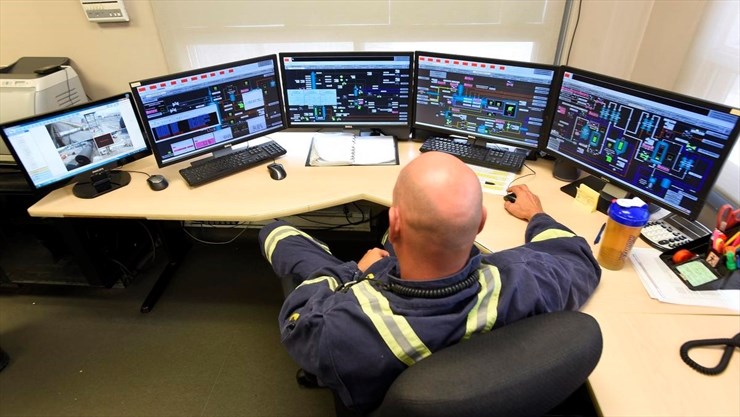The control room for production at World Energy’s biodiesel plant on Wentworth Street North – John Rennison,The Hamilton Spectator
Plant-based plants create billion-dollar economic harvest for Hamilton
Leonardo DiCaprio and the brains behind Bunge’s Hamilton operation hit the jackpot when shares of Beyond Meat surged in the spring.
They were among early investors in the company whose stock roared past its $25-a-share IPO price in May to the current $160 range. Grain and oilseed handler Bunge reported a $135 million spike from the plant-based play in its second quarter results.
The late-August announcement that KFC is making a chickenless wing with Beyond Meat turned the heat up a little more on a nonmeat sector whose growth has attracted the attention of meat makers like Maple Leaf Foods.
The milestone for plant-based food producers makes this a good moment to go in for a close-up on the giant agrifood players on the harbour — from sugar and flour mills at Pier 10 tucked in behind the Collective Arts brewery to the grain silos along Eastport Blvd. that obscure the view of steel factories from the QEW.
The $200 million invested into these facilities in the past decade and the 3 million metric tonnes of soybeans, corn, wheat and other commodities shipped annually — a third of the port’s cargo — has created a billion-dollar agrifood sector that is chasing down steel as the city’s second-largest economic driver.
Parrish & Heimbecker — Century-old P&H arrived in Hamilton a decade ago and built 60,000 tonnes of storage space in two large domes and a flour mill, the province’s first in 75 years. An expansion is underway to double milling at the Hamilton operation, part of the private Winnipeg company’s network of 60 grain terminals and mills across Canada. Total invested in Hamilton: $140 million.
The current activity on the pier contrasts with the former tenants — 1920s-era brick sheds that occasionally served as a movie shoot location back when Russell Crowe starred in movies such as Cinderella Man.
Sucro Sourcing — The sugar refinery opened on Ferguson North alongside P&H in early 2019 with a $10 million storage and processing facility. Through operations in Florida, Mexico and Trinidad and Hamilton, Sucro supplies food and energy producers.
Bunge — The location at Pier 11 dates back to 1946 as Canada Vegetable Oil Products. Bunge took over the oilseed crushing operation in 2004 and expanded to the south side of Burlington Street in 2008 with a $60-million edible oil refinery. The two-hundred-year-old company based in St. Louis operates in 40 countries with divisions that extend from handling and milling of grains to sugar, fertilizer and bioenergy.
Sylvite Agri-Svc — The fertilizer handler built its $5 million location on Pier 12 in 2012.
G3 — The company operates 20 Canadian grain handling depots. It is jointly held by Bunge and the Saudi Agricultural and Livestock Investment Co. and was formed as a successor to the Canada Wheat Board when it was privatized in 2003. The $50 million grain handling operation on Pier 26 was built in 2017. The 50,000 tonne storage unit alongside the QEW at Eastport Blvd. provides rail, marine loading with the capability of handling up to 400 trucks a day.
Richardson — The private Winnipeg-based company’s operations are spread out across Canada, the U.S. and Britain. In 1998, it built its Hamilton grain-handling terminal at Pier 25 on Eastport Blvd. and expanded it with $5-million upgrade. The 160-year-old company started on a wharf in Kingston, Ont. arranging grain shipments through sailing ships whose captains acted as grain agents.
Agrico — Established a century as one of North America’s earliest fertilizer companies, Agrico has operated at Pier 25 since 1987. Under an assortment of domes and tanks along Eastport Blvd. it provides 55,000 tonnes dry storage and 42,000 tonnes liquid storage.
New projects — A $16-million project announced in August by the Hamilton-Oshawa Port Authority will cut a deeper channel alongside the Parrish & Heimbecker flour mill at Pier 10 to cut down on the backlog of ships in the harbour waiting to pick up milled products bound for Asia and Europe export markets.
It follows on the announcement of a $36-million project called the Westport Modernization that will reconfigure a 115-acre site between Pier 12 and Pier 15 for more cargo-handling and rail service.
Fluke Transportation is building a 56,000 sq. ft climate-controlled warehouse space on the new Westport site for agrifood and consumer products. It adds to the 275,000 sq. ft of Fluke’s existing warehouse space.
This wider number of Hamilton-based grain handlers is beneficial to operations such as Canada Bread, says Todd Austin, marketing manager for the Grain Farmers of Ontario, which represents 200 Hamilton-area grain farmers and 28,000 across the province.
Multiple grain handlers on the harbour means greater competition for local soybean, wheat and corn crops.
“It’s certainly been a good opportunity for the Ontario farmer,” Austin said. Grain and oilseed sales from local farms total about $38 million a year.
Though export destinations of Europe and Asia remain significant markets, “the domestic market is just as important,” Austin said.
“The nice thing about Hamilton is it’s positioned well to ship to a big consumer area because it’s really close to a lot of big urban centres in Canada and the U.S,” he said.
And the growing presence of biofuel operators in the port of Hamilton is added opportunity for local farmers.
Oilseed processed by Bunge is a component of clean-burning and sustainable biodiesel fuels. The Pier 11 terminals of Shell and Greenergy ship and store both biodiesel and ethanol.
A refinery on Pier 12 makes biodiesel. Originally built as the Biox biodiesel plant in 2005, the alternative fuel maker operates as the Canadian arm of Boston-based World Energy.
The Wentworth Street North plant recycles animal fat and used cooking oil to supply the biodiesel fuel market whose growth is tied to fuel mandates being applied by Canadian, U.S. and other governments.
Here, at World Energy, the agrifood cycle comes full circle as animal fat collected from rendering operations such as Maple Leaf is mixed with recycled oil that might have started life as an oilseed product a block a way at Bunge.
It gets boiled down to biodiesel, piped next door to Shell, which pumps it into trucks that deliver livestock feed to area farms and pick up grain bound for silos back at Hamilton Harbour.
SOURCE: The Spec
https://www.thespec.com/news-story/9583129-seed-capital-agrifood-giants-stalk-the-city-of-steel/
thogue@thespec.com


